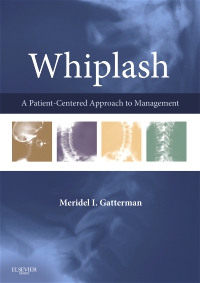
Whiplash - Elsevier eBook on VitalSource, 1st Edition
Elsevier eBook on VitalSource

Now $62.99
Providing a balanced, evidence-based discussion of whiplash and its associated disorders, Whiplash: A Patient Centered Approach to Management compiles information from many sources into a single, definitive reference. It clearly delineates rationales and procedures, covering cervical spine anatomy, neurology, kinesiology, epidemiology, patient history and assessment, imaging, soft tissue injuries, articular lesions, rehabilitation, and prognosis. Using numerous full-color photos and illustrations, an expert author team led by Dr. Meridel Gatterman offers concrete guidelines for a patient-centered approach to care of whiplash and whiplash-related conditions -- one that recommends minimally invasive procedures and therapies whenever possible. A companion Evolve website includes video clips showing stretching exercises, printable patient handouts, and narrated PowerPoint slides.
-
- A patient-centered approach to care emphasizes working with patients as partners, with both preferring minimally invasive procedures and therapies where appropriate, in a way that promotes self-healing, a holistic approach to the patient, and a humanistic attitude with regard to the patient/practitioner relationship.
- An easy-to-follow organization helps you to clearly identify whiplash and plan a course of treatment, beginning with an in-depth description of whiplash and the various approaches to treatment and moving on to cover the anatomy of the cervical spine, the mechanism of injury, physical examination, and imaging, then continuing with the management of whiplash injuries and complications such as headaches and joint injuries.
- Full-color photos and illustrations clarify concepts and procedures.
- Evidence-based content is based on findings in current literature, and cited in chapter references.
- Coverage of both typical and less common types of whiplash injuries helps you accurately assess varied symptoms and avoid overlooking any related signs and symptoms.
- Detailed coverage of the relationship between the cervical spine and the cervical distribution of the autonomic nervous system helps you recognize the potential complications of whiplash and how nerve anatomy informs these complications.
- More than 20 tables and charts provide a quick reference to facilitate review of the material.
- A glossary provides definitions and pronunciations of terms related to whiplash.
- Expert author Meridel Gatterman, MA, DC, MEd, is one of the leading chiropractic academics in the U.S., has written several other chiropractic textbooks and many peer-reviewed journal articles, has served as both a Dean and Director for two different chiropractic schools, and currently acts as a Consultant to the Oregon Board of Chiropractic Examiners.
- A companion Evolve website includes video clips of a chiropractor performing stretching exercises, plus an image collection, narrated PowerPoint slides, and printable patient handouts.
-
1. Introduction
"Whiplash" as an Entity
Whiplash: What is it?
The Epidemiology of "Whiplash" Injuries
Patient-Centered Care
The Characteristics of Patient-Centered Care
Emphasis on Self Healing
Holistic Approach to the Patient
A Humanist Attitude
Working with Patients as Partners
Shared Decision Making
Integrative Care
The Paradigm Concept
Clashing Paradigms
What is Integrative Care?
Evidence-Based Care
History of Whiplash
Terminology
Mechanism of Injury
2. Functional Anatomy of the Cervical Spine
Embryological Development of the Spinal Motion Segments
Somatogenesis
Components of the Lower Spinal Motion Segments
The Autonomic Nervous System
Conclusion
3. Patient History and Mechanism of Injury
Brachial Plexus
CNS
ANS
4. Physical Examination
Listening to the Patient
The Pain Drawing
Chief Complaints and General Assessment
Analysis of Cervical Motion
Segmental Cervical Movement
Neurological Evaluation
Sensory Testing
Reflexes
Testing for Muscle Strength
Provocation Tests for Cervical Spine Disorders
Compression Tests
Foraminal Compression
Assessment of Cervical Nerve Function Through Compression
Disc Herniation
Distraction
Differentiation of Sprain from Sprain
Assessment of Vertebral Artery Function
Cervicobrachial Pain
Outcome Evaluation
Neck Disability Index
5. Imaging
Acute Injury
Chronic Injury
6. Management of Muscle Injury and Myofascial Pain Syndromes
Historical Overview of Muscle Pain Literature
Theoretical Models of Muscle and Myofascial pain
7. Headache in Whiplash: A Comprehensive Overview
Taking a Headache History
Types of Headache That Might be Encountered
Examining the Headache Patient
Deciding What the Diagnoses are
What are Possible Mechanisms of Whiplash-associated Headache?
Managing Headache in the Whiplash Patient
8. Whiplash Associated Disorders of Joints and Ligamentous Structures
Stability of the Cervical Spine and Whiplash Injury
Cervical Joint Sprain
Whiplash Associated Joint Dysfunction
Clinical Indicators of Cervical Subluxation
Palpatory Findings Indicating Cervical Subluxation
Reliability and Validity of Clinical Indicators of Subluxation
Syndromes Associated with Subluxation of the Cervical Articulations
Whiplash Associated Headache Related to Joint Subluxation
Incidence of Post Whiplash Headache
Headache Response to Manipulation
Posterior Cervical Sympathetic Syndrome and the Vertebral Arteries
Cervicogenic Dorsalgia
Cervical-Brachial Syndrome
Conservative Management of Cervicobrachial Pain
Cervical Subluxation Syndromes
9. Epidemiology of Whiplash Injuries
Basic Epidemiological Terms
Frequency of Whiplash
Whiplash Risk Factors
Societal Impact
A Whiplash Culture
Prevention
10. The Safety and Effectiveness of Common Treatments for Whiplash
Judging Safety and Effectiveness: An Evidence Based Approach
The Quebec Whiplash Task Force
The Bone & Joint Decade Task Force
Comparing Safety and Effectiveness of Common Therapies
Simple Analgesics
Other Drugs
Evidence for Pharmacological Therapies
Conservative Physical Treatments
Non-conservative Interventions
Surgical Interventions
11. Prognosis of Whiplash Associated Disorders
Prognostic Factors
Psychological and Psychosocial Factors That Delay Recovery
In the Patient's Interest

 as described in our
as described in our 